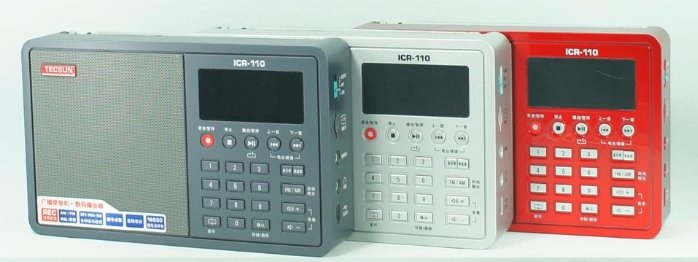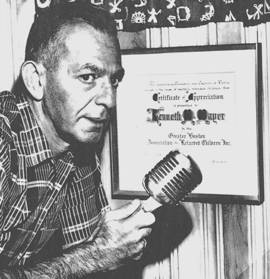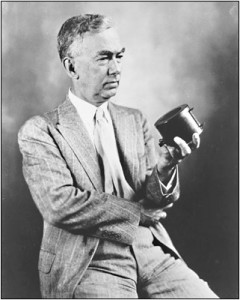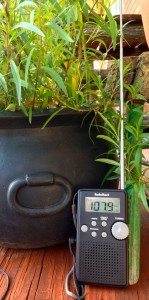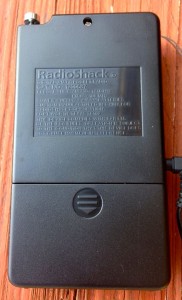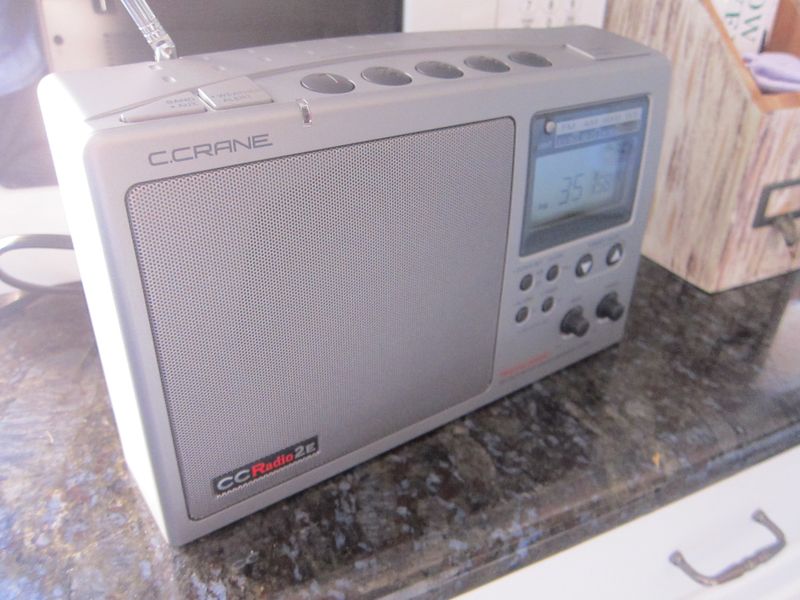 Searching for an AM/FM radio great audio? Check out Jeff’s first look at the CCRadio 2E.
Searching for an AM/FM radio great audio? Check out Jeff’s first look at the CCRadio 2E.
Tag Archives: AM
The Tecsun ICR-110 packs AM/FM and digital recording/playback
In a comment, SWLing Post reader Owl mentions:
“Tecsun has just released ICR-110 which is as BIG as the PL-880 and seems to have the same speaker too.”
The ICR-110 can be found on eBay–click here to search. At $46.00 US shipped, I’m very tempted to purchase it. Though it lacks shortwave, it appears that it can record AM (MW) and FM broadcast stations in either MP3 or WAV formats. While I’ve yet to find a radio that can make a digital recording with acceptable fidelity (the CC Witness Plus being a notable exception) I would like to think the engineers at Tecsun have nailed it.
I have a friend who has recently purchased the ICR-110, and am looking forward to his review! (hint, hint)
Can you help Bill find a Kenny Mayer aircheck?
SWLing Post reader, Bill Albert, writes:
“I am trying to find an “air check” of Kenny Mayer, a well-known Boston late-night radio show host (now deceased) during the 1960’s and 1970’s. His show aired from 12-2AM Mondays, so it was one of the few interesting things one could listen to at that hour. He would play bits from classic old comedy albums (e.g., Bill Cosby and Bob Newhart in their stand-up days), and he’d ad-lib the sponsors’ advertisement spots himself. He was really a character, and his voice had a very unique cadence and intonation. I did manage to find one clip from a 1966 show featuring a routine entitled “The Great Society Affair”—a parody of the wedding of President Johnson’s daughter. God, how long ago that was!! Different world. There was also a bit by Godfrey Cambridge, and a number of Kenny’s home-made commercials. However, I’ve since lost that clip, and in any case I played and replayed it to exhaustion. If anyone has another “air check” of Kenny’s show, I would love to get a copy.”
If anyone has a lead for Bill, please comment!
If you’d like to read more about Ken Mayer, Bill suggests this article.
[Update: When I posted this request a few hours ago, I mistakenly posted the photo and information for Kenny Meyer instead of Kenny Mayer. Both of these gentlemen were prominent figures in the Boston broadcasting scene around the same time period (hence my confusion!).]
FCC championing change that could “Bolster AM Radio”
It appears that FCC Commissioner, Ajit Pai, is pushing a plan to revitalize declining AM radio station and listener numbers in the US. Read some of the details below or the full article on the New York Times website.
Many thanks to David Goren for the tip!
(Source: NY Times)
The [The Federal Communications Commission] announced late Thursday that it would begin seeking public comment on numerous changes[.]
[…]Because of interference caused by consumer electronics, smartphones and the like, AM radio often seems to deliver mostly static. The AM audience has fallen to 15 percent of all radio listeners, down from 50 percent as recently as 1978. While the FM audience has fallen as well, it draws more than five times the audience of AM.
[Steps include] eliminating a regulation requiring stations to prove that any new equipment decreases interference with other stations — a requirement that is expensive, cumbersome and difficult to meet.
The F.C.C. has also proposed eliminating or loosening rules that govern nighttime transmissions by AM stations. Those regulations currently require many AM stations to reduce their power or cease operating at night to avoid interference with other stations.
[…]The current regulations make it difficult for AM stations to locate towers where they will not interfere with nearby stations at night. They also put conflicting requirements on stations, mandating that they still cover most of their broadcast territory even while operating at reduced power.
The proposed new rules, the commission said, aim at keeping more stations on the air at night.
[T]he F.C.C. said it was ready to make available to current FM stations what are known as FM translators — empty spots on the FM dial where AM stations can broadcast. Those are particularly valuable in urban areas, where tall buildings with steel frames or aluminum siding can block AM signals, degrading reception.
The rise and decline of AM radio in Pittsburgh
Many thanks to Jeff Brady who shared this article from the Pittsburgh Post-Gazette. While this article focuses on Pittsburgh’s AM radio scene, it’s certainly reflective of a common theme throughout the US and in other countries.
(Source: Pittsburgh Post-Gazette)
By Adrian McCoy and Maria Sciullo / Pittsburgh Post-Gazette
“Radio, as we know it, may have begun on a bet.
Frank Conrad, assistant chief engineer for Westinghouse in the early 20th century, wanted to see whether a new watch was keeping correct time. In 1912, he made a $5 wager with colleague Thomas Perkins. But how to verify his claim?
Tinkering with materials in his Wilkinsburg garage, Conrad created a small receiver capable of picking up time signals from the U.S. Naval Observatory in Arlington, Va.
He won his bet and went on to design bigger and better radios for Westinghouse. In turn, Westinghouse became a key player in turning the hobby of a few radio enthusiasts into an industry that changed the world.
Pittsburgh’s radio history is the history of modern radio.
For AM radio — and the radio industry in general — the hits just keep coming. Rapid technological changes, government legislation, aging demographics and a shifting media landscape have combined to erode AM’s once massive audience. Better clarity through FM, HD and satellite, and more diverse programming have resulted in AM leaning heavily on two formats: talk and sports.
Still, it all started here.” [Continue reading…]
For more information about Frank Conrad, check out this biography on Wikipedia. Read the full Gazette-Times article The Rise and Decline of AM Radio by clicking here.
Review of the RadioShack AM/FM portable digital radio, Model 12-587
Three days a week, my father––now in his seventies––takes a three mile walk through his home town, revisiting the neighborhoods of his youth. He began the walks upon retirement, and in my opinion, the routine has helped keep him in great shape. When he first started walking I learned he was carrying around a heavy AM/FM radio with him. I bought him a bargain one-off Coby AM/FM portable that is not only lightweight but sports a handy neck strap. Dad’s loved it. Indeed––much to my surprise––it’s lasted about ten years, and is still playing, although starting to show signs of wear…
So I decided it was time to test drive a suitable replacement. After searching, I found the RadioShack Model 12-587 AM/FM radio. At a clearance price of $14.99 (US), there will be no loss of sleep if Dad misplaces it or drops it on the pavement.
Still, I couldn’t resist giving it the once-over, and thought I might share the mini review that resulted. As I always say for radios in this price range, my expectations were low.
Here’s a summary of this little AM/FM radio’s pros and cons:
Pros:
- Very good FM selectivity and sensitivity
- Excellent FM stereo lock
- Scan function both useful and quick
- 10 AM and 10 FM memories (see con)
- Large, amber back-lit LCD display
- Simple control lock switch on right side
- AM (medium wave) sensitivity adequate
- AM nulling above average
- Plastic “blister” packaging very easy to open!
Cons:
- Tinny sounding audio via built-in speaker
- Headphone audio lacks high/low; mid-range only
- Memory allocations supposedly volatile (when batteries are replaced)
- AM frequency steps fixed at 10 kHz (cannot adapt to 9 kHz steps used in rest of the world)
- AM (medium wave) sensitivity mediocre at best
- Complete mute while tuning; not capable of band-scanning
- Dimple on tuning knob not useful
- Very sensitive to noise (QRM) on the AM band, resulting in static popping/crackling in audio
Obviously, this is not a radio for the radio hobbyist or world traveler, as it lacks any real medium wave sensitivity and cannot tune in 9 kHz steps. FM tuning is also locked on odd frequencies, thus will not work throughout parts of the world with even spacing. And though the radio is touted as having “extended bass,” the audio is tinny, even via headphones.
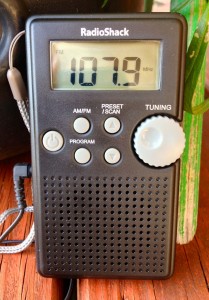 BUT. This is a perfect example of a situation in which, though cons outweigh pros, the RS Model 12-587 is a great match for its intended purpose: my father’s morning walks. Why? It’s a simple-to-operate radio with a large, back-lit display (Dad won’t need to put on his glasses to read it). It receives local AM and FM stations very well. The mid-range audio––while lacking ample fidelity for music––are perfect for the talk shows he listens to while walking. The radio is durable, lightweight, easy to tune, and has a lock feature. It is also remarkably easy to program memories: simply press the program button until preset flashes in the LCD display, use the scan up/down buttons to choose a memory number then press program again. It’s also very affordable, so no problem to replace as necessary.
BUT. This is a perfect example of a situation in which, though cons outweigh pros, the RS Model 12-587 is a great match for its intended purpose: my father’s morning walks. Why? It’s a simple-to-operate radio with a large, back-lit display (Dad won’t need to put on his glasses to read it). It receives local AM and FM stations very well. The mid-range audio––while lacking ample fidelity for music––are perfect for the talk shows he listens to while walking. The radio is durable, lightweight, easy to tune, and has a lock feature. It is also remarkably easy to program memories: simply press the program button until preset flashes in the LCD display, use the scan up/down buttons to choose a memory number then press program again. It’s also very affordable, so no problem to replace as necessary.
In conclusion, the RS Model 12-587 is not a performance radio––and I wouldn’t generally recommend it––but it suits my father’s needs very well. Like to walk or run? Maybe it’s just what you’re looking for, too.
The Take Away interviews Ajit Pai
 Many thanks to Dan Srebnick for sending a link to this piece on The Take Away.
Many thanks to Dan Srebnick for sending a link to this piece on The Take Away.
In The Quest To Save AM Radio, John Hockenberry talks about AM radio nostalgia and then interviews Ajit Pai (who was mentioned in a post a few days ago).
Click here to download an MP3 of the interview or simply listen via the embedded player below.

